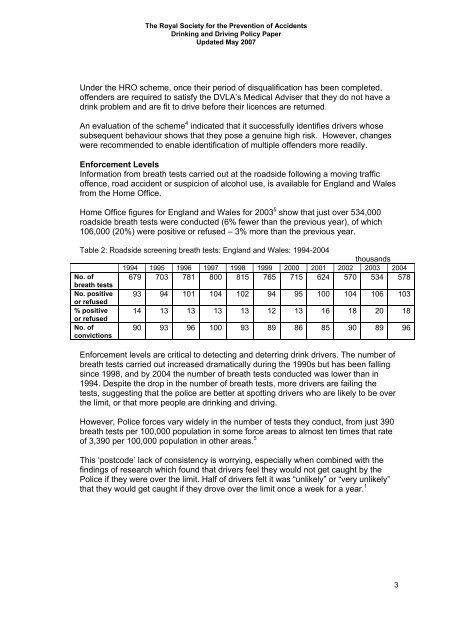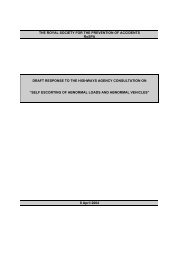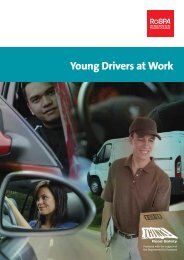RoSPA Drinking and Driving Policy Paper 2007
RoSPA Drinking and Driving Policy Paper 2007
RoSPA Drinking and Driving Policy Paper 2007
Create successful ePaper yourself
Turn your PDF publications into a flip-book with our unique Google optimized e-Paper software.
The Royal Society for the Prevention of Accidents<br />
<strong>Drinking</strong> <strong>and</strong> <strong>Driving</strong> <strong>Policy</strong> <strong>Paper</strong><br />
Updated May <strong>2007</strong><br />
Under the HRO scheme, once their period of disqualification has been completed,<br />
offenders are required to satisfy the DVLA’s Medical Adviser that they do not have a<br />
drink problem <strong>and</strong> are fit to drive before their licences are returned.<br />
An evaluation of the scheme 4 indicated that it successfully identifies drivers whose<br />
subsequent behaviour shows that they pose a genuine high risk. However, changes<br />
were recommended to enable identification of multiple offenders more readily.<br />
Enforcement Levels<br />
Information from breath tests carried out at the roadside following a moving traffic<br />
offence, road accident or suspicion of alcohol use, is available for Engl<strong>and</strong> <strong>and</strong> Wales<br />
from the Home Office.<br />
Home Office figures for Engl<strong>and</strong> <strong>and</strong> Wales for 2003 5 show that just over 534,000<br />
roadside breath tests were conducted (6% fewer than the previous year), of which<br />
106,000 (20%) were positive or refused – 3% more than the previous year.<br />
Table 2: Roadside screening breath tests: Engl<strong>and</strong> <strong>and</strong> Wales: 1994-2004<br />
thous<strong>and</strong>s<br />
1994 1995 1996 1997 1998 1999 2000 2001 2002 2003 2004<br />
No. of 679 703 781 800 815 765 715 624 570 534 578<br />
breath tests<br />
No. positive 93 94 101 104 102 94 95 100 104 106 103<br />
or refused<br />
% positive 14 13 13 13 13 12 13 16 18 20 18<br />
or refused<br />
No. of<br />
convictions<br />
90 93 96 100 93 89 86 85 90 89 96<br />
Enforcement levels are critical to detecting <strong>and</strong> deterring drink drivers. The number of<br />
breath tests carried out increased dramatically during the 1990s but has been falling<br />
since 1998, <strong>and</strong> by 2004 the number of breath tests conducted was lower than in<br />
1994. Despite the drop in the number of breath tests, more drivers are failing the<br />
tests, suggesting that the police are better at spotting drivers who are likely to be over<br />
the limit, or that more people are drinking <strong>and</strong> driving.<br />
However, Police forces vary widely in the number of tests they conduct, from just 390<br />
breath tests per 100,000 population in some force areas to almost ten times that rate<br />
of 3,390 per 100,000 population in other areas. 5<br />
This ‘postcode’ lack of consistency is worrying, especially when combined with the<br />
findings of research which found that drivers feel they would not get caught by the<br />
Police if they were over the limit. Half of drivers felt it was “unlikely” or “very unlikely”<br />
that they would get caught if they drove over the limit once a week for a year. 1 3
















